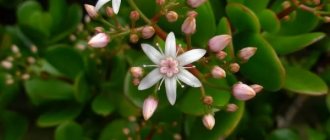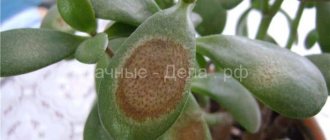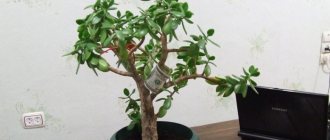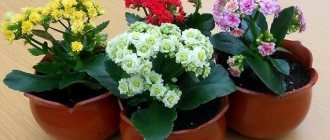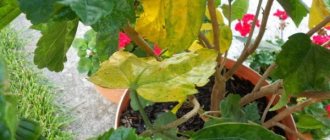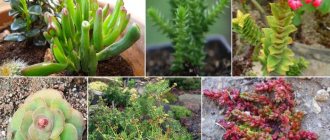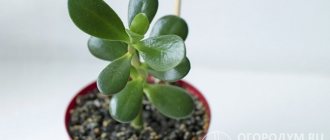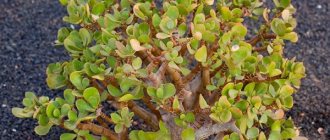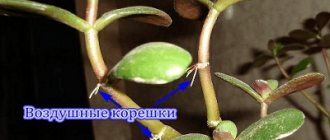The money tree (crassula or crassula) received its name because of the shape of the leaves, similar to round coins. Nutrients accumulate in their fleshy structure. According to popular belief, the owner’s wealth depends on the size of these “coins” and on the condition of the plant, since it is believed that it harmonizes the atmosphere of the home, extinguishes negative emotions and gives positive energy.
The money tree is a succulent plant and is easy to care for. But at the same time, many gardeners face a dilemma: why doesn’t the money tree grow at home, doesn’t develop, and often dies? To prevent the death of the plant, we will tell you how to revive the fat plant and give recommendations on proper care and control of possible diseases and pests.
There are several types of money tree. Crassula is grown at home:
- tree or cotyledon (Crassula arborescens);
- silver (Crassula argenta);
- oval (Crassula ovata).
All species are called money tree, despite the different color of the leaves: green or dark green. Shiny and silvery plates may be covered with a reddish border or red spots on the reverse side.
Why doesn't the fat plant develop?
The main reasons that the development of the tree is stagnant and the shoots do not grow:
- Root rot. You cannot overwater the plant. Otherwise, the roots rot and growth stops, the trunk deteriorates, the plant tips over to one side and dies. We wrote in more detail about why the root and trunk of the fat plant rot in this article.
- Pot size. The root system of the Crassula is shallow. You should find a low pot, taking into account the space for the drainage layer. Otherwise, the roots will have to entwine the earthen ball for a long time. The aboveground mass will not develop. There is a risk of flooding the plant.
- Draft. Has a negative effect on the condition of Crassula. May cause leaf loss and stunted growth.
- Diseases:
- Mealybug. A pest that sucks plant juices. The fat plant stops growing and fades. Without treatment, he dies.
- Shield. Small sucking insects. Affects leaves. Crassula stops growing and withers.
- Spider mite. Sits on the back of the sheet. It can be detected when a thin cobweb appears on the plant.
- Fungal infection. Crassula will stop growing. Brown, wrinkled spots will appear on the leaves.
In a separate article we talked about all the pests and diseases of the fat plant.
Is it possible to make flower food with your own hands?
The question of what else can be fed to the fat woman is solved with the help of proven folk recipes. They use minerals.
Natural sources of calcium include chicken egg shells. Gardeners use it to create a nutritious tincture, as a drainage base and for dry enrichment of the soil. The shells are pre-washed and calcined in the oven or in a frying pan.
Instructions for preparing the tincture:
- Pre-washed and calcined shells of 10 eggs are ground into powder.
- Pour into a glass container and pour boiling water over it.
- Insist for 14 days in a shaded room.
- Used as a solution for irrigation instead of ordinary water.
The use of eggshells as a substitute for classic drainage is carried out in a standard way. After washing and calcining, large pieces are carefully laid out at the bottom of the container to a height of no more than 2 cm, and covered with earth. This method will help avoid moisture accumulation near the root system and its rotting.
Note! The dry method is used when transplanting crassula. Pre-crushed 2 teaspoons of shells are poured into a pot, sprinkled with soil and the plant is planted.
The eggshell infusion should sit for 14 days.
Why is it developing poorly or slowly?
- Lighting. With a lack of light, the plant becomes lethargic, grows poorly, or, conversely, stretches out.
- Burns on the leaves can slow down growth. When exposed to direct sunlight, the plant fades and withers.
- Lack of feeding. A lack of nutrients will lead to disruption of natural life processes and slow growth.
Important! Excess fertilizer can cause the succulent to become diseased. - Inappropriate temperature conditions. Large temperature changes inhibit growth.
- Priming. The soil should be porous and light, acidic with low nitrogen content.
Incorrectly selected substrate
Crassula needs light, not too nutritious soil that allows moisture and air to pass through well. If the soil is heavy and contains a lot of humus, the crop will slow down and lose its decorative appearance.
Solution. The soil needs to be replaced. Use succulent substrate. You can prepare the mixture yourself: take two parts of peat, turf and leaf soil, three parts of coarse sand. Place a drainage layer of three to four centimeters at the bottom of the container.
What to do to speed up the growth of Crassula?
To renew and accelerate the growth of a succulent at home, it is necessary to reconsider its care:
- Check the size of the pot. Remove the plant from the flowerpot; if the lump of earth is large and not entwined with roots, replace it with a more suitable one.
- Replace the soil. Add: leaf soil, turf soil, coarse quartz sand or river pebbles.
- Adjust lighting. Place in the sun, but shade it from direct rays.
- Adjust soil moisture. Water only after the soil has completely dried.
If pests are detected, treat the plant:
- Mealybug - wipe with alcohol, vodka or soap solution. Rinse with a warm shower.
- Spider mites - treat with a solution of laundry soap, infusion of garlic, dandelion or onion peel.
Important! Be sure to treat the back side of the leaf properly, as spider mites settle there. - Shield. Soap solution. The disadvantage of this method is the need to repeat the treatment to get rid of hatched individuals. Examine the root of the crassula. While maintaining healthy roots, transplant into a new pot, removing all rotten tissue. Treat with charcoal.
How to care for Crassula?
The optimal location for Crassula is a southeast or southwest window. In winter, the plant needs additional lighting.
Crassula has seasonal requirements that you need to know:
- Provide the “money tree” with 3 months of rest. From late November to February.
- Maintain a lower temperature, up to 14-16 degrees Celsius.
- Water less often. Ideally, once a month.
- Do not feed.
Video with useful tips for caring for crassula:
Varieties
| Photo | Description |
| Tree-like This is a squat plant with a massive and thick stem. The bark is smooth and green. An adult plant can grow up to three meters. The leaves of this species are fleshy, curved, green-gray in color. The leaf size varies from 2 to 5 cm. It blooms mainly in spring with medium-sized, white-pink flowers. | |
| Silver This is a bushy variety, reaching one and a half meters in height. The leaf is oval, not pointed, leathery in shape. It is noteworthy that the sheets form paired development and have some inclusions of light shades. The variety also differs in its root system. It is powerful, dense and thick. The flowers form in spring, are odorless and form racemes of pink color. | |
| Oval The leaf is oval with pointed ends, dark green in color. The stem is dense, large and rough, brown in color. It blooms quite rarely with white small inflorescences. The flowering period occurs at the beginning of spring. |
Under favorable conditions created indoors, the tree of happiness can grow up to two meters in height. An important requirement for growing is low air humidity. The use of modern air conditioners is a disastrous condition for growing Crassula.
What if the tree has grown or only stretches upward?
- To form a crown, turn it towards the light in different directions.
- Periodically pinch the top.
- When it grows, cut off the excess branches, leaving 4 leaves. For work, use a disinfected pruner or a sharp knife. Treat the cut with crushed charcoal.
- Pinch out growing side shoots.
What to do if your plant does not want to bloom, dries out, or a white coating appears on it? Why do the leaves of the Crassula become soft and wrinkled, turn yellow and fall off? You will find answers to all questions on our website. Experts in the field of floriculture will tell you whether and how to save Crassula if it is sick.
Crassula (“money tree”) is completely unpretentious in care. But, in order to grow it beautiful and healthy, you need to learn in advance the simple rules of caring for the plant. Be always ready and help the flower cope with difficulties at any time.
Origin
The money tree is native to the Southern Hemisphere, Africa. This means that the plant naturally grows in hot climates. Based on this, you need to create an exotic atmosphere for the fat woman. Flower growers should take into account the biological feature of the plant, which, in fact, explains the unpretentiousness of the indoor flower. The fact is that a succulent is able to create a reserve of moisture for itself, accumulating it in the leaves, due to which it survives in unfavorable conditions. Therefore, for some owners, the fat plant does not dry out when it is in cool and shaded places. However, the quality of its development and exterior features in this case are significantly reduced.
Having once left their favorite plant to its own devices and not taking proper care of it, some gardeners may wonder why the money tree does not grow. Two conditions have been noted in the disturbance of plant development. Sometimes the bush grows very slowly and looks painful. But it also happens that it completely stops its development, its branches begin to die. In both the first and second cases, it is necessary to take urgent measures to save the plant.
